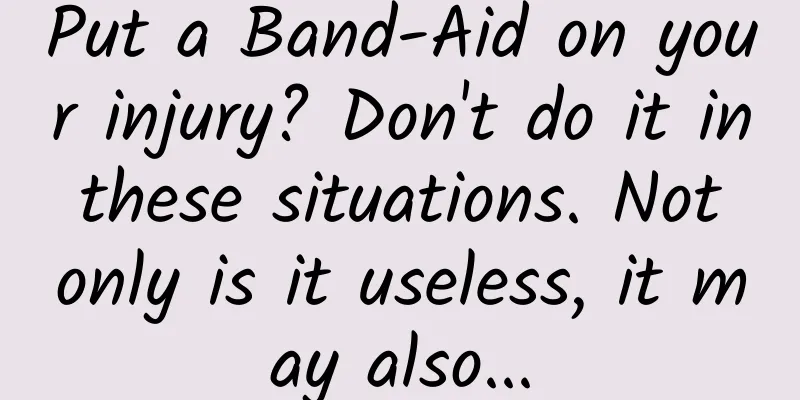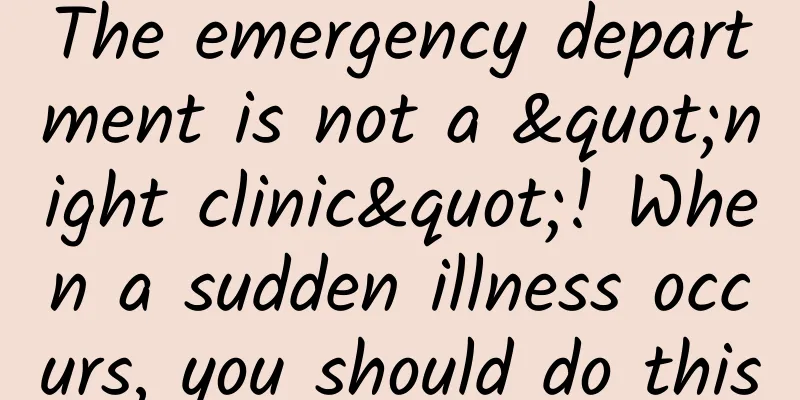Put a Band-Aid on your injury? Don't do it in these situations. Not only is it useless, it may also...

|
gossip "Band-Aid is a magical tool for trauma?" All minor wounds can be treated with a Band-Aid. Rumor Analysis This is not the case and needs to be discussed on a case-by-case basis. In general, Band-Aids are more suitable for small wounds that are shallow, neat, and do not bleed much. In some cases, improper use of Band-Aids may bring other health risks. A small piece of adhesive tape with a soft pad in the middle, which can be applied wherever there is an injury... Band-Aids have become a very familiar old friend in our lives. When we have a minor injury and it is not worth going to the hospital, it can help us. Therefore, it is recommended that you put some Band-Aids at home, at work, and in your bag. Band-Aid, are you sure you know how to use it? Although band-aids are very convenient to use, they must be used correctly to protect wounds and facilitate healing. If they are used in the wrong place or improperly, they may cause us greater harm. Today, let's talk briefly about how to use small band-aids. Copyrighted stock images, no reproduction is authorized Some friends may think, it’s just a Band-Aid, who doesn’t know how to use it? That’s not necessarily true. First, please judge for yourself which of the following injuries can be treated with Band-Aids and which cannot? A4 paper cut a small hole I accidentally fell while running and scratched a large area of my skin. Scalded and blistered when pouring boiling water Deep wounds that bleed continuously I accidentally got my foot pierced by a nail. I accidentally cut my hand while cutting vegetables. Injuries from thorns/shells when handling seafood Wounds that have become festering Bitten by a dog/cat/snake or other animal I believe that after reading the following content, you will be able to draw the correct conclusions to these questions. Band-Aids, when are they used? The main function of a bandage is to protect the wound. It can prevent dirt, especially bacteria, from entering the wound and causing secondary infection. It can also temporarily protect the wound like a layer of armor to reduce the irritation and pain caused by friction and touch. Another function is to keep the environment near the wound mild and moist, which can promote wound healing. In addition, it can absorb a small amount of liquid exuding from the wound to avoid staining clothes. It seems that any wound can be covered with a bandage, but this is not actually the case. Bandages are mainly used for small, shallow wounds with little bleeding. The following situations are not suitable for bandages: It is not suitable for wounds with heavy bleeding. Not suitable for animal bites Not suitable for small and deep wounds Not suitable for burns It is not suitable for use on suppurative wounds. Next, let’s talk about it in detail while comparing it with the questions in the previous article. 1. A small cut on the A4 paper Yes, it can be used. Band-aids are very suitable for wounds that are shallow, small, bleed little, and are very painful when touched. 2. I accidentally fell while running and scratched a large piece of skin. Large-area abrasions are often more numerous and dirty, and require thorough cleaning and disinfection, and medical dressings when necessary, but are not suitable for bandages. Here is a small principle: if the area of the wound is larger than the small pad on the bandage, don't force a bandage. 3. Scalding and blisters when pouring boiling water In the case of burns and blisters, there is no need to put a Band-Aid on it. Doing so may tear the skin. 4. The wound is deep and bleeding continuously In this case, it is usually necessary to apply pressure to stop the bleeding and seek medical attention promptly. Just putting on a Band-Aid will not help. 5. Accidentally got your foot pierced by a nail In this case, the wound is often deeper and may contain dirt deep inside, and there is also a risk of tetanus, so it is best to go to the hospital for disinfection and bandaging, and get a tetanus shot if necessary, rather than just putting on a Band-Aid and calling it a day. 6. Accidentally cut your hand while cutting vegetables Yes, if the wound is neat and there is not much bleeding, you can use a band-aid, but remember to clean and disinfect the wound first. 7. Hands injured by thorns/shells when handling seafood It needs to be handled properly, not just with a band-aid. Many seafood may carry Vibrio vulnificus, which can infect through wounds and can even be fatal in severe cases. Therefore, we must be careful when handling seafood, and wash our hands with soap after handling seafood. If you accidentally injure your hand and feel unwell afterwards, you should seek medical attention immediately. 8. Wounds that have become festering Do not use it. Putting a band-aid on a wound that has already become festering will not help drain the pus and will more easily lead to bacterial growth. 9. Bitten by a dog/cat/snake or other animal No, animal bites are often complicated, with punctures, lacerations, etc. The wounds are deep and uneven, and there may be many pathogens in the mouth of the animal. Covering the wound with a band-aid will not help. The correct way is to wash the wound with soapy water and seek medical attention in time. If necessary, rabies immunoglobulin and rabies vaccine, as well as tetanus vaccine, need to be injected. Band-Aids should be used like this After figuring out the situations in which band-aids can be used, we also need to understand the correct way to use them. Just follow the steps below: Clean your hands, either with wipes or hand sanitizer. Check whether the wound surface is clean. If necessary, rinse with clean water, soapy water or saline to remove dirt. If conditions permit, you can use iodine to disinfect. It is especially recommended to use disposable iodine cotton swabs. If conditions permit, you can apply some antibiotic ointment on the wound to help it heal. Check whether the band-aid packaging is intact and not damaged. If it is damaged, the band-aid may be contaminated and needs to be replaced. Use a Band-Aid on the wound and avoid touching the padding in the middle of the Band-Aid with your hands to avoid contaminating the wound. Check whether the tightness of the bandage is appropriate and does not affect activities and blood circulation. Change or remove the bandage within 24 hours. Copyright image, no permission to reprint What is a Band-Aid? Some of you may be a little confused when you see this. Isn't it called "Band-Aid"? Why does the article keep saying "Band-Aid"? In fact, there is a little difference between the two (but not big). The Band-Aid we usually talk about often has the following statement in the instructions, saying that it does not contain any drug ingredients and is subject to the relevant regulations on medical devices. And we can also see in the registration information that it is a medical device. The picture is taken from the product manual of the Band-Aid Although the "Band-Aid" looks like a "Band-Aid", it often contains some anti-inflammatory and antiseptic ingredients, such as benzalkonium chloride. Therefore, we can see the drug ingredients and drug-related implementation standards on the instructions of this type of Band-Aid, and Band-Aids are also sold and managed as over-the-counter drugs. The picture is taken from the product manual of Band-Aid Compared with band-aids, band-aids have a little more ability to kill bacteria and reduce inflammation, but there is no essential difference in the method of use, so for convenience, this article will use band-aids as an example. As long as it is a regular brand purchased through regular channels, and you can find the approval number and registration certificate number, it is a qualified product and can be used with confidence. Looking in the mirror of rumors Many drugs or medical devices have their applicable scopes when used. We should use them according to the doctor's instructions or read the instructions carefully and use them according to the situation. If we simply call them "magic weapons" and use them regardless of the situation, it may bring unnecessary risks. Author: Ding Zong Reviewer: Tang Qin, Director of the Science Popularization Department of the Chinese Medical Association, National Health Science Popularization Expert |
<<: #千万IP创科学热门# How can a snail with the word “parrot” added to it not be a snail?
>>: For the first time in the world, how difficult is it to "dig soil" on the back of the moon?
Recommend
How does Tik Tok create a new traffic empire?
This explosive traffic platform, with its huge ce...
Mango TV is unique and independent, and it is more than just a single broadcaster
The fierce competition in the video website indust...
Google launches new Qaya service: Help creators easily build online stores
The new project, Qaya, co-founded by Nathaniel Na...
"How did a deer from across the ocean end up on our national emblem?"
This is the national emblem of Antigua and Barbud...
How can Toutiao quickly gain millions of followers? Share 10 marketing tricks!
Many people have noticed that Toutiao, which has ...
Tips for setting up advertising and promotion accounts!
Friends who have done SEM know that account build...
A highly profitable naming project, Douyin leads to 300+ orders, selflessly sharing it with you
Today I will share with you a highly profitable m...
How can TO B operations reach new heights without anyone to lead or learn from?
In the Internet space, the word " operation ...
How can we as a self-media person receive and complete more orders?
In general, I think, first of all, you must dare ...
Is the click-through rate of products in Douyin’s live broadcast room low? Share 5 tips!
If a live broadcast is likened to the process of ...
When exploring an extraterrestrial planet, does the probe fly in a straight line? Learn more about the Hohmann transfer orbit
In "Elements" written by the ancient Gr...
How much does it cost to customize the Zhaotong digital mini program? Zhaotong Digital Mini Program Customized Price Inquiry
Zhaotong Digital Mini Program Customization Price...
Continuous update: A collapse accident occurred at Xinjing Coal Mine in Alxa Left Banner, Inner Mongolia, and rescue is ongoing
February 23, 8:30 At 8 am on the 23rd, CCTV repor...
Changan Mazda MAZDA EZ-6 sets new value standard for new energy joint ventures, makes global debut at Beijing Auto Show
On April 25, Changan Mazda's first electric s...
Don’t feed them blindly! The more you eat, the better the “nutritious meal” of crops
As the saying goes, "Man is iron, rice is st...









